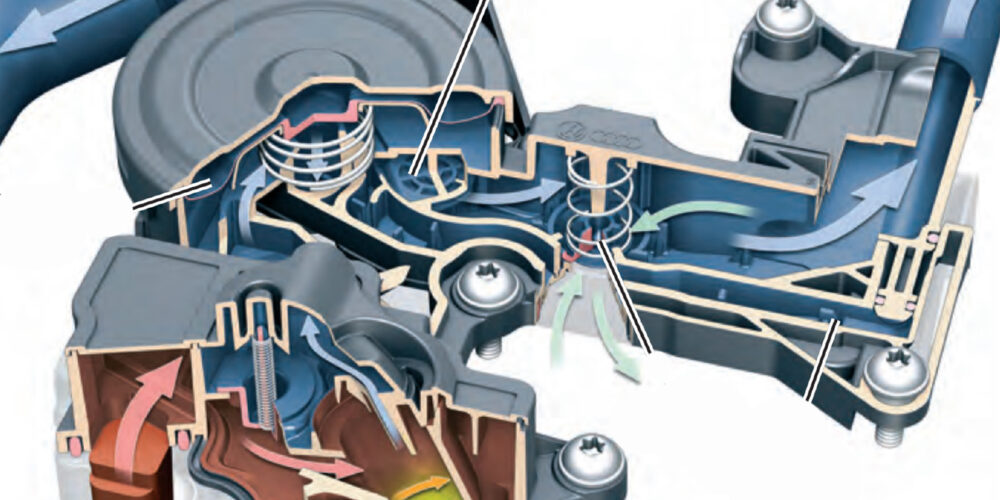Affected models:
E82 and E88 (1 Series) with N51, N52K and K54 engines produced from January 2008
E90 and E91 (3 Series) with N52 engine produced from March 2005 through June 2006
E90, E91, E92 and E93 (3 Series) with N51, N52K and N54 engines produced from July 2006
E85 and E86 (Z4) with N52 engine produced from January 2006
E83 (X3) with N52K engine produced from September 2006
E60 and E61 (5 Series) with N52, N52K and N54 engines produced from March 2005
E70 (X5) with N52K engine produced from October 2006
E71 (X6) with N54 engine produced from January 2008.
The “Service Engine Soon” (MIL) lamp is illuminated and a power reduction is clearly perceptible. This situation can occur after driving for some time with the engine already at full operating temperature. If the ignition is cycled, the engine then usually performs normally.
The following faults are stored in the DME:
• 2A82 VANOS intake – stiff, jammed mechanically
• 2A87 VANOS exhaust – stiff, jammed mechanically
• 3100 Boost-pressure control, deactivation – boost-pressure buildup prohibited (N54 only).
The VANOS faults can be caused by an insufficient oil pressure supply to the inlet VANOS adjustment unit. To effectively move the camshafts to the target positions in the specified time and under all engine conditions, sufficient oil pressure supply to the VANOS control pistons must always be available.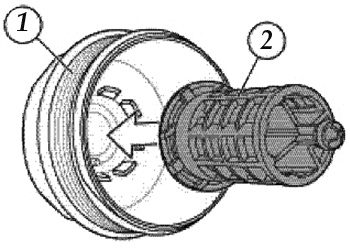
When the engine operation requires that the VANOS quickly advance or retard the intake or exhaust camshaft, fault 2A82 or 2A87 may be set if the camshaft is “late,” or does not reach the target position. In this situation, engine power may be reduced and a check control message is displayed. The consequential fault 3100 can be set in the DME fault memory as well.
Service Procedure:
1. Perform all applicable test plans completely for the faults stored. A mechanical restriction or electrical failure of the VANOS solenoid and/or the electrical circuit can cause insufficient oil supply to the VANOS assemblies as well. If the completed test plans results are inconclusive, then proceed to step 2. See Fig. 1.
2. The oil filter cap insert may have been inadvertently removed during the vehicle’s last oil service. If this insert is not installed, it will result in non-filtered engine oil being supplied to the engine, thus possibly clogging or damaging the VANOS solenoids.
If the oil filter cap insert is found to be missing, the entire oil filter housing cap must be replaced (refer to the EPC).
Note: Repairs related to step 2 are not considered a defect in materials or workmanship.
3. Replace both VANOS solenoids (P/N 11 36 7 585 425), change the engine oil and filter (P/N 11 42 7 566 327) and reset the service data only when applicable, as outlined in the Warranty Information section. Drive the vehicle to verify effectiveness.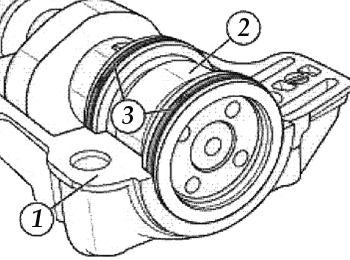
If excessive wear to the camshaft bearing ledge is found, it is only necessary to replace the camshaft hook ring seals and the affected camshaft bearing ledge. N51, N52 and N52K intake camshaft bearing ledges and hook ring seals cannot be replaced separately. Cylinder head replacement requires a TeileClearing PuMA case.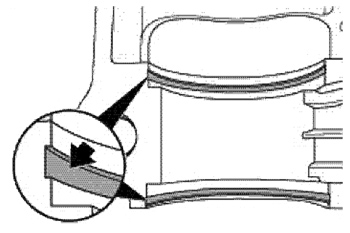
Camshaft Bearing Ledge Wear Assessment:
While performing the test plan for the VANOS faults stored (ABL-DIT-B1214_NGNWA or E), the inspection of the camshaft hook ring seals is advised.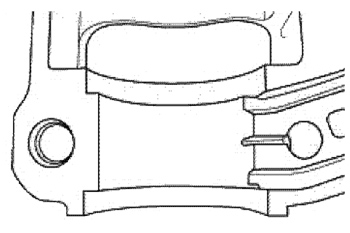
Figs. 2, 3 and 4 are illustrations of worn camshaft bearing ledges and the acceptable wear of the camshaft bearing ledge.
Note the deep grooves worn into the camshaft bearing ledge by the camshaft hook ring seals in Fig. 3. The camshaft bearing ledge is worn.
Fig. 4 shows acceptable camshaft bearing ledge — minor gray wear marks from the rotation of the camshaft are normal. If deep grooves are not apparent, the camshaft bearing ledge is acceptable and should not be replaced.
Courtesy of Mitchell 1.




